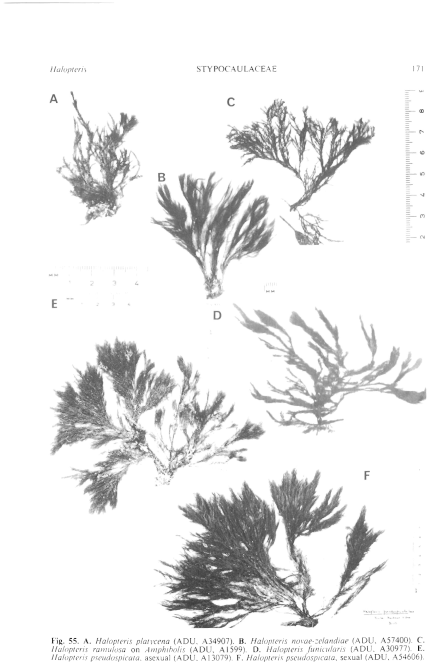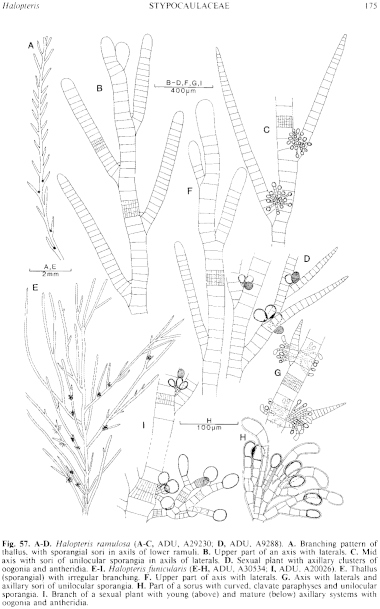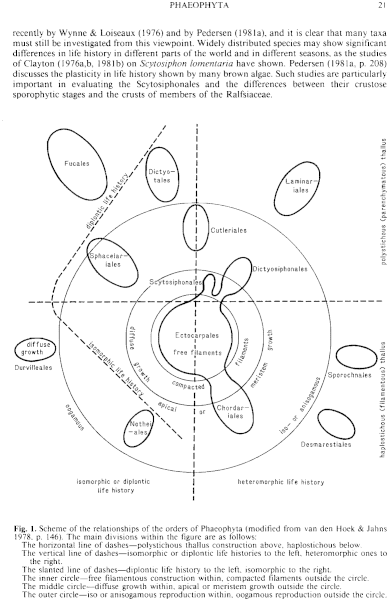|
|
|
|
|
|||||||||||
|
Electronic Flora of South Australia Species Fact Sheet
Phylum Phaeophyta – Order Sphacelariales – Family Stypocaulaceae
Selected citations: Lindauer et al. 1961: 167, fig. 20. Moore 1951: 273, figs 28, 29. Womersley 1967: 201.
Synonyms
Sphaceluria muelleri Sonder 1855: 507.
Stypocaulon muelleri (Sonder) Geyler 1866: 498, pl. 34 figs 14–18.
Thallus (Fig. 551)) dark brown, 6–20 (–25) cm long, usually densely tufted with a rhizoidal holdfast 2–5 mm across and one to several erect, much branched axes, with both normal and adventitious laterals, basally denuded, usually epilithic. Branching of several orders, irregularly radial (Fig. 57E) with laterals mostly every (4–) 7–15 (–20) segments (Fig. 57F) but with some long, little-branched laterals, with lesser laterals determinate and tapering to a point; mid and lower axes producing descending rhizoids which corticate the axes and form the holdfast; phaeophycean hairs absent. Axes (150–) 200–300 µm in diameter with segments L/B 0.5–1.0. corticated by a single layer of small, rectangular cells (without development of any secondary cortex); primary laterals 100–150 µm in diameter with segments L/B 0.5–0.8 (–1.0); ultimate laterals 50–70 µm in diameter near their bases with segments L/B 0.3–0.6 (–0.8); rhizoids arising from pericysts; adventitious branchlets frequent in mid and lower thallus.
Reproduction: Unilocular sporangia (Fig. 57G,H) in loose to moderately dense sori in axils of scattered or consecutive laterals, with erect, sporangia-bearing filaments intermixed with curved, sterile, clavate, paraphyses which extend past the sporangia (Fig. 57H); sporangia on branched pedicels several cells long, subspherical to ovoid, 26–40 µm in diameter. Sexual plants (Fig. 571) with mixed clusters of oogonia and antheridia in axils of laterals, or on branched adventitious laterals, or occasionally laterally on branches; sex organs on 2–4 celled pedicels, oogonia subspherical to ovoid, 60–100 µm in diameter, antheridia subspherical to slightly ovoid, 60–110 µm in diameter.
Type from Auckland Is; in Herb. Montagne, PC.
Selected specimens: Elliston, S. Aust., drift ( Womersley, 13.i.1951; ADU, A13449). Seal Bay, Kangaroo I., S. Aust., drift (Womersley, 29.x.1966; ADU, A30977). Robe, S. Aust., drift (Womersley, 13.xi.1955; ADU, A20026, sexual). 1.3 km off Cape Northumberland, S. Aust., 15 m deep (Shepherd, 26.x.1977; ADU, A55058, sexual). Eddystone Point, Tas., upper sublittoral pools (Bennett, 20.vi.1954; ADU, A19810). Stapleton Point, Prosser Bay, Tas., 8–12 m deep (Olsen, 21.vi.1966; ADU, A30534).
Distribution: Cold temperate coasts of New Zealand, Subantarctic Islands, South America and South Africa.
In southern Australia, from Fowler Bay, S. Aust. to Sealers Cove, Vic., and around Tasmania.
Taxonomic notes: H. funicularis is similar in habit and dimensions to H. pseudospicata differing only in the reproductive structures. The sori of unilocular sporangia occur in the axils of scattered or consecutive laterals, and consist of sporangium-bearing filaments intermixed with sterile, curved, clavate paraphyses. They are more irregular and looser than in H. pseudospicata and give a less spike-like appearance. The sexual plants ascribed to H..funicularis differ from those of H. pseudospicata by having the oogonia and antheridia on branched, adventitious ramuli (as well as axillary) whereas those of the latter are all axillary on little-branched pedicels. However, this association of sexual plants with each species is circumstantial, based on distribution of the two species and the more regular sexual sori resembling the asexual sori in H. pseudospicata, and has not been verified by cultural studies.
The holotype of Sphacelaria muelleri Sonder, from Wilsons Promontory, Vic., is in MEL, 15790, and is typical of H. funicularis.
References:
GEYLER, T. (1866). Zur Kenntnis der Sphacelariaceen. Jb. wiss. Bot. 4, 479–535, Plates 34–36.
LINDAUER, V.W., CHAPMAN, V.J. & AIKEN, M. (1961). The marine algae of New Zealand. II. Phaeophyceae. Nova Hedwigia 3, 129–350, Plates 57–97.
MOORE, L.B. (1951). Reproduction in Halopteris (Sphacelariales). Ann. Bot., N.S., 15, 265–278.
SONDER, O.W. (1855). Algae annis 1852 et 1853 collectae. Linnaea 26, 506–528.
WOMERSLEY, H.B.S. (1967). A critical survey of the marine algae of southern Australia. II. Phaeophyta. Aust. J. Bot. 15, 189–270.
The Marine Benthic Flora of Southern Australia Part II complete list of references.
Publication:
Womersley, H.B.S. (14 December, 1987)
The Marine Benthic Flora of Southern Australia
Part II
©Board of the Botanic Gardens and State Herbarium, Government of South Australia
Illustrations in Womersley Part II, 1997: FIGS 55D, 57E-1.

Figure 55 enlarge
Fig. 55. A. Halopteris platycena (ADU, A34907). B. Halopteris novae-zelandiae (ADU, A57400). C. Halopteris ramulosa on Amphibolis (ADU, A 1599). D. Halopteris funicularis (ADU, A30977). E. Halopteris pseudospicata, asexual (ADU, A13079). F. Halopteris pseudospicata, sexual (ADU, A54606).

Figure 57 enlarge
Fig. 57. A–D. Halopteris ramulosa (A–C, ADU, A29230; D, ADU, A9288). A. Branching pattern of thallus, with sporangial sori in axils of lower ramuli. B. Upper part of an axis with laterals. C. Mid axis with sori of unilocular sporangia in axils of laterals. D. Sexual plant with axillary clusters of oogonia and antheridia. E–I. Halopteris funicularis (E–H, ADU, A30534; I, ADU, A20026). E. Thallus (sporangial) with irregular branching. F. Upper part of axis with laterals. G. Axis with laterals and axillary sori of unilocular sporangia. H. Part of a sorus with curved, clavate paraphyses and unilocular sporangia. I. Branch of a sexual plant with young (above) and mature (below) axillary systems with oogonia and antheridia.

Figure 1 enlarge
Fig. 1. Scheme of the relationships of the orders of Phaeophyta (modified from van den Hoek & Jahns 1978, p. 146). The main divisions within the figure are as follows:
The horizontal line of dashes-polystichous thallus construction above, haplostichous below.
The vertical line of dashes-isomorphic or diplontic life histories to the left, heteromorphic ones to the right.
The slanted line of dashes-diplontic life history to the left, isomorphic to the right.
The inner circle-free filamentous construction within, compacted filaments outside the circle.
The middle circle-diffuse growth within, apical or meristem growth outside the circle.
The outer circle-iso or anisogamous reproduction within, oogamous reproduction outside the circle.

|
Email Contact: State Herbarium of South Australia |

|